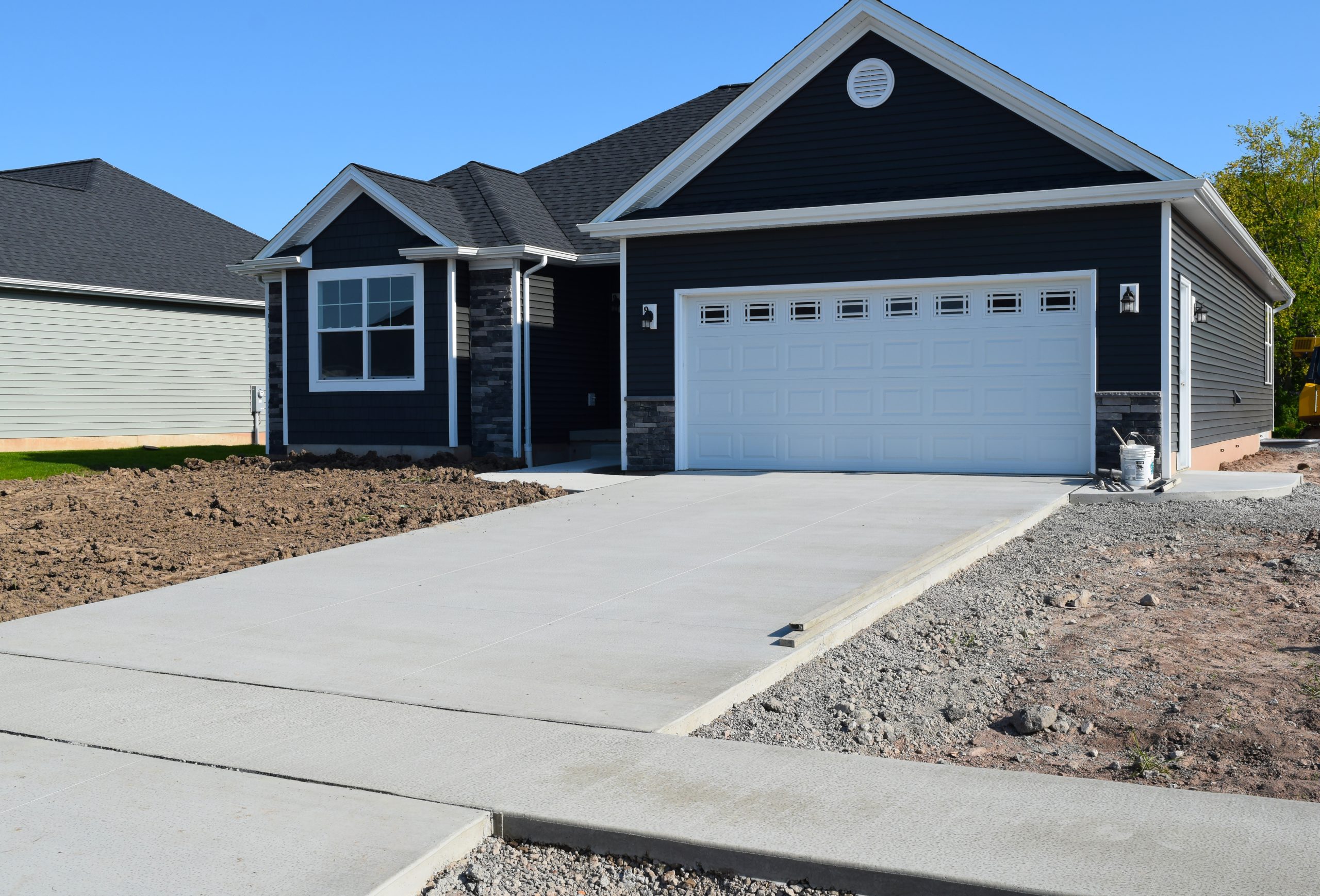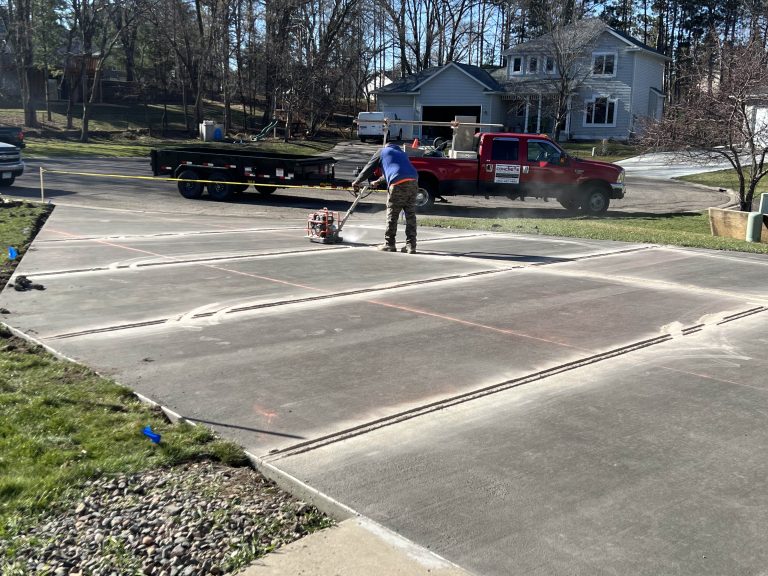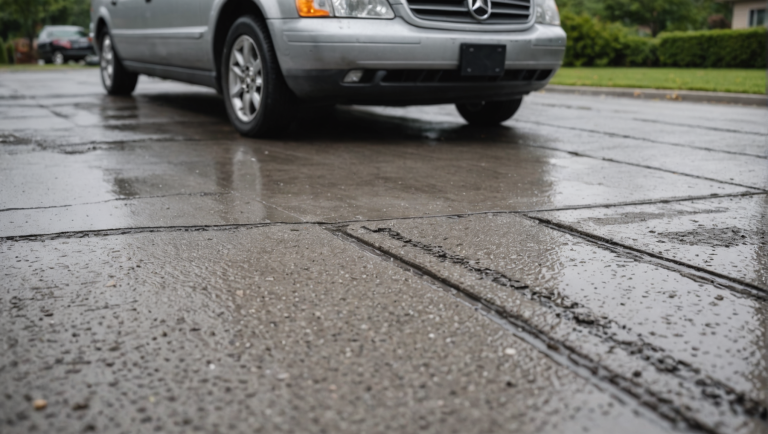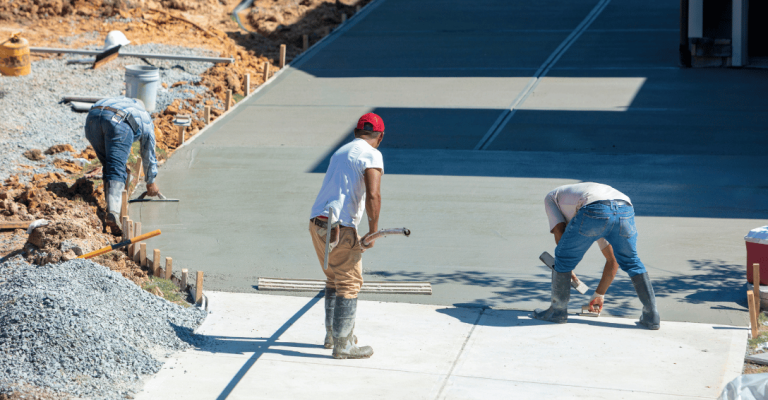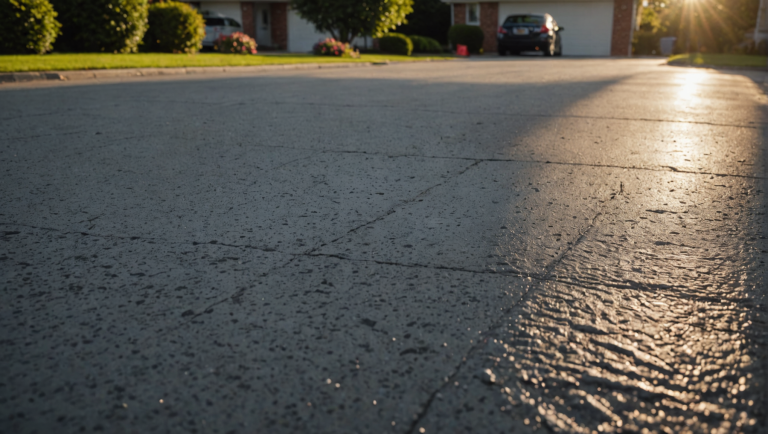Types of Concrete Driveways Enhancing Your Properties Appeal
The aesthetic and functional benefits of various types of concrete driveways are often overlooked when considering property enhancements. Two popular options, stamped and exposed aggregate driveways, offer unique visual appeal and durability. Stamped concrete mimics textures like brick or stone, while exposed aggregate reveals a colorful array of incorporated stones. Each choice can notably enhance your home’s curb appeal, but how can you determine which option is right for your property? The answer lies in understanding their unique characteristics, installation process and maintenance requirements.
Understanding Concrete Driveway Basics
The homeowner’s journey to understanding concrete driveway basics begins with an appreciation of its unique composition, a harmonious blend of cement, aggregate, and water, meticulously engineered to provide durability, aesthetic appeal, and longevity. It’s a story of synergy, with each element playing its integral role, bonding together to form the resilient structure that graces your home’s facade.
Diving deeper into the concrete’s composition, cement serves as the binder, the adhesive agent that holds the entire mix together. It’s the essence that transforms separate elements into a cohesive whole. The aggregate, typically composed of sand, gravel, or crushed stone, adds volume, enhancing the concrete’s overall strength and stability. Water, the final component, activates the cement, enabling it to bind the aggregate together in an intricate dance of molecular bonding.
The science behind this composition is as fascinating as it is complex. Each ingredient is carefully proportioned, adhering to precise standards to achieve the desired strength and durability. The result is a tribute to the beauty of engineering, a concrete driveway that not only serves a functional purpose but also contributes significantly to your home’s aesthetic appeal.
Each concrete driveway is a narrative of science, art, and innovation, interwoven to create a masterpiece of durability and design.
Benefits of Concrete Driveways
Often overlooked, the advantages of concrete driveways extend far beyond their fundamental role of providing a durable, smooth surface for vehicles. The artistic potential of this medium allows you to transform what may seem like a mundane feature into an eye-catching focal point of your home, elevating your property’s appeal.
The table below encapsulates some of the key benefits of concrete driveways:
| Benefit | Details | Impact on Property Appeal |
|---|---|---|
| Durability | Concrete driveways are incredibly strong and last for many years with minimal maintenance. | High durability enhances the long-term attractiveness of your property. |
| Versatility | Concrete can be shaped, textured, colored, and patterned to match your aesthetic preferences. | This flexibility allows for design continuity and a cohesive visual narrative. |
| Cost-Effectiveness | Over time, the low maintenance costs and longevity of concrete driveways provide excellent value for money. | A well-maintained driveway can boost property value and appeal to potential buyers. |
| Sustainability | Concrete can be recycled, reducing the environmental impact. | Eco-conscious visitors will appreciate this sustainable choice, adding to your property’s allure. |
To truly feel at home, your driveway should not just be functional but also reflect your personal style and values. A concrete driveway provides this unique blend of utility and aesthetic appeal, making it a wise investment for homeowners.
Classic Plain Concrete Driveway
Embodying simplicity and elegance, a classic plain concrete driveway serves as a timeless choice for homeowners seeking durability without compromising on aesthetic appeal. This driveway style is a reflection of the beauty of minimalism, showcasing the raw, unadorned allure of concrete in its most basic yet impressive form.
The classic plain concrete driveway is not merely a functional element but an artistic declaration. Its smooth, unblemished surface reflects an aesthetic reminiscent of an empty canvas, beckoning the observer’s imagination to fill the void. The clean lines and neutral tones serve to highlight the surrounding landscape, augmenting the overall visual harmony of your property.
More than just a practical solution, a plain concrete driveway is a symbol of your dedication to lasting quality and refined taste. It’s a driveway that withstands the test of time, enduring the harshness of weather and the daily wear and tear with unyielding grace. Its enduring character is underpinned by its inherent strength, making it a wise investment for those who value longevity and aesthetics equally.
Stamped Concrete Driveway Designs
Exploring the realm of artistic innovation, stamped concrete driveway designs offer a captivating fusion of durability and artistry, adding a touch of sophistication to your property. These driveways are not just practical but showcase the exquisite craftsmanship that goes into their creation.
Emulating the intricate textures and detailed designs of brick, slate, stone, or even wood, stamped concrete driveways can enhance your home’s visual appeal, creating an ambiance of luxury and refinement.
The charm of these driveways lies in their adaptability. They can be tailored to complement your home’s architectural style, color palette, or individual preferences. From elaborate floral motifs to simple geometric shapes, the design possibilities are as limitless as your creativity.
Furthermore, the durability of the concrete ensures longevity, making it a worthwhile investment for your home. Stamped concrete driveways are not only visually appealing but also resilient to weathering, guaranteeing they retain their allure for years to come.
Exposed Aggregate Concrete Driveways
Moving from stamped concrete, we now step into the domain of Exposed Aggregate Concrete Driveways, a diverse tapestry of design and durability. This approach, steeped in technique yet brimming with aesthetic potential, warrants exploration into its material selection, the intricacies of its installation, and its long-term resilience.
Therefore, we set off on a journey to unveil the beauty and practicality of this driveway type, one aggregate at a time.
Choosing Aggregate Materials
When it comes to selecting aggregate materials for exposed aggregate concrete driveways, a plethora of options present themselves, each offering a unique blend of texture, color, and durability to enhance your property’s curb appeal. From the rustic charm of crushed granite to the eye-catching vibrancy of colored glass, every material tells a story, inviting viewers into a space that is distinctly yours.
The choice of aggregate material is not merely aesthetic; it’s also about the harmonious interplay of form and function. For instance, pea gravel, with its smooth, round shape, is not only pleasing to the eye but also offers excellent traction, especially in wet conditions.
On the other hand, quartz, with its crystalline sparkle, can infuse your driveway with a sense of luxury, while also providing a durable surface resistant to weathering.
Ultimately, your choice of aggregate material should reflect your personal style and the overall aesthetic of your property. Whether you prefer the timeless elegance of marble chips or the warm, earthy tones of decomposed granite, there’s a material out there that perfectly encapsulates your vision.
As you commence on this journey of selection, remember, you’re not just choosing a driveway, but a tribute to your taste, a celebration of your unique identity.
Installation Process Explained
Delving into the critical phase of installation, the creation of an exposed aggregate concrete driveway unfolds as a meticulously planned and skillfully executed sequence of steps. Commencing with a well-prepared subbase, the process puts a premium on precision, ensuring the longevity of your investment and the enhancement of your property’s appeal.
The first stage involves the meticulous preparation of the ground surface. This involves clearing any debris and ensuring a stable, flat surface. A layer of compacted subbase, typically crushed stone, is added for stability. It’s then time to form the perimeters, using wooden planks to outline the driveway’s shape and size.
Next comes the pouring of the concrete mix, a carefully calibrated blend of cement, sand, water, and your chosen aggregate. It’s skillfully spread across the prepared surface, then screeded and bull floated to create a flat, smooth surface.
The artistry truly unfolds in the next step, as the top layer of concrete is carefully brushed away, revealing the beauty of the aggregate beneath. This step requires exact timing, as the concrete needs to be partially set but not fully hardened.
With a final seal to lock the aggregate in place, your driveway stands as a tribute to craftsmanship and aesthetic innovation.
Maintenance and Durability
After the meticulous installation and artistic revelation of the aggregate, the focus now shifts to the longevity and preservation of your exposed aggregate concrete driveway. A tribute to both strength and beauty, exposed aggregate is a hardy material, its resilience paralleling its aesthetic charm. Yet, to secure its lasting splendor, certain maintenance steps are necessary.
Regular sealing, typically needed every 3-5 years, is advised to protect the surface from wear, staining, and weathering. This not only enhances the vibrancy of the aggregate colors but also fortifies the concrete against the ravages of time. The sealing process is an act of nurturing, a protective embrace that secures the longevity of your driveway.
In terms of durability, exposed aggregate concrete driveways are an exceptional choice. They withstand heavy loads and harsh weather conditions, their robust structure unyielding to the rigors of everyday use. But beyond their practicality, they are a canvas for nature’s artistry, their pebble-like surface capturing the essence of the earth’s raw beauty.
Maintenance Tips for Concrete Driveways
Moving seamlessly from the various types of concrete driveways, we approach the vital stage of upkeep.
The longevity and aesthetics of your driveway pivot on three key practices: regular cleaning, stain management, and sealant application.
Our exploration into these practices will illuminate the path towards a durable and visually pleasing concrete driveway.
Regular Cleaning Routines
While the durability of concrete driveways is well-known, instituting a regular cleaning routine can enhance their longevity and aesthetic appeal. The accumulation of debris, dirt, and leaves can lead to discoloration and damage, subtly diminishing the overall allure of your property. However, a consistent, thoughtful cleaning regimen can maintain the driveway’s robust charm.
Start by scheduling routine sweeping, perhaps weekly, to prevent the build-up of surface dirt and debris. Utilize a stiff-bristled broom to efficiently remove them, preserving the driveway’s clean lines and smooth texture. As seasons change, the frequency might need to be adjusted. The autumn months, for example, could necessitate more frequent sweeps due to leaf accumulation.
Every few months, consider a deeper clean. Pressure washing, done with care and precision, can rejuvenate the concrete surface, revealing its innate strength and beauty. The force of the water dislodges embedded dirt, restoring the driveway’s pristine gray hue. However, refrain from excessive pressure that could damage the surface.
Dealing With Stains
Beyond routine cleaning and pressure washing, homeowners must also confront the inevitable reality of stains on their concrete driveways, requiring a different set of maintenance strategies. These stains can be stubborn, diminishing the overall appeal of your property. But don’t despair, every stain has a solution.
To tackle this task, understanding the type of stain is paramount. Whether it’s oil, grease, rust, or leaf stains, each has a unique treatment. This will help optimize your cleaning process, rendering it efficient and effective.
Here’s a concise table to guide you:
| Type of Stain | Cleaner | Method |
|---|---|---|
| Oil & Grease | Degreaser or Detergent | Scrub with a stiff brush |
| Rust | Oxalic Acid | Apply and let sit, then rinse |
| Leaf | Mild Detergent | Scrub with a brush, then rinse |
Preventive Sealant Application
In the quest for a well-maintained and visually appealing concrete driveway, application of a preventive sealant emerges as a proactive measure of paramount importance. This ingenious method serves as an invisible barrier, guarding the aesthetic allure and structural integrity of your driveway from the relentless onslaught of elements such as water, oil, and UV rays.
Sublime in its simplicity, the sealant application process commences with a meticulous cleansing of the surface, banishing dust and debris from the canvas upon which your driveway’s longevity is crafted. Post-cleanse, the sealant, a concoction brewed for resilience, is tenderly applied, creating a sheen that is as protective as it is visually striking.
The sealant’s charm lies in its dual role. Not only does it safeguard your driveway’s dignified facade from unsightly stains, but it also imparts an enticing gloss, enhancing the richness of the concrete’s texture. Essentially, it nurtures your driveway’s aging process, ensuring that it ages like fine wine rather than weathered stone.
Imbuing a sense of belonging, a well-sealed driveway communicates, in silent eloquence, your commitment to your property’s upkeep. Through the prism of preventive sealant application, your driveway’s story of endurance and elegance is etched in concrete, narrated for years to come.
Comparing Costs: Concrete Vs Other Materials
A thorough comparison of costs can reveal that concrete driveways, despite their upfront expenditure, often prove to be a more cost-effective choice when compared with other driveway materials. This is primarily due to concrete’s durability and low-maintenance nature over the long term, making it a wise investment for homeowners seeking a blend of aesthetic appeal and practicality.
To elucidate this point, consider the following table that illustrates the average cost, durability, and maintenance needs of concrete compared to other popular driveway materials:
| Material | Average Cost per Square Foot | Durability | Maintenance |
|---|---|---|---|
| Concrete | $3 – $10 | High | Low |
| Asphalt | $2 – $5 | Moderate | High |
| Gravel | $1 – $3 | Low | Very High |
| Pavers | $10 – $50 | High | Moderate |
It is clear that while concrete may require a higher upfront cost, its long-term benefits in terms of durability and low maintenance make it a cost-effective choice. Considering the longevity of your driveway and the aesthetic value it brings to your property, a concrete driveway emerges as an investment that pays for itself over time.
Frequently Asked Questions
What Is the Average Lifespan of a Concrete Driveway?
A concrete driveway, when properly installed and maintained, can serve your home for about 30 years. This lifespan can extend even further with regular sealing against weather and wear, ensuring its enduring functionality and aesthetic appeal.
Can Concrete Driveways Be Painted or Dyed for Aesthetic Appeal?
Absolutely, concrete driveways can be painted or dyed to amplify their aesthetic appeal. This creative choice can transform a dull, grey surface into an appealing feature, enhancing the overall visual harmony of your property.
How Does Weather Affect the Durability of a Concrete Driveway?
Weather greatly impacts concrete driveway durability. Extreme temperatures cause expansion and contraction, leading to cracks. Rain can erode the surface over time, while freezing conditions can cause frost heave, damaging the driveway’s structural integrity.
Are There Eco-Friendly Alternatives to Traditional Concrete for Driveways?
Yes, there are eco-friendly alternatives to traditional concrete for driveways. Permeable concrete and recycled concrete aggregate are both sustainable choices that reduce environmental impact while still providing a durable and appealing driveway surface.
Can Concrete Driveways Be Installed Over Existing Pavement?
Yes, concrete driveways can indeed be installed over existing pavement. This process, known as overlaying, allows for an efficient, cost-effective renovation without the need for complete removal of the current pavement.

